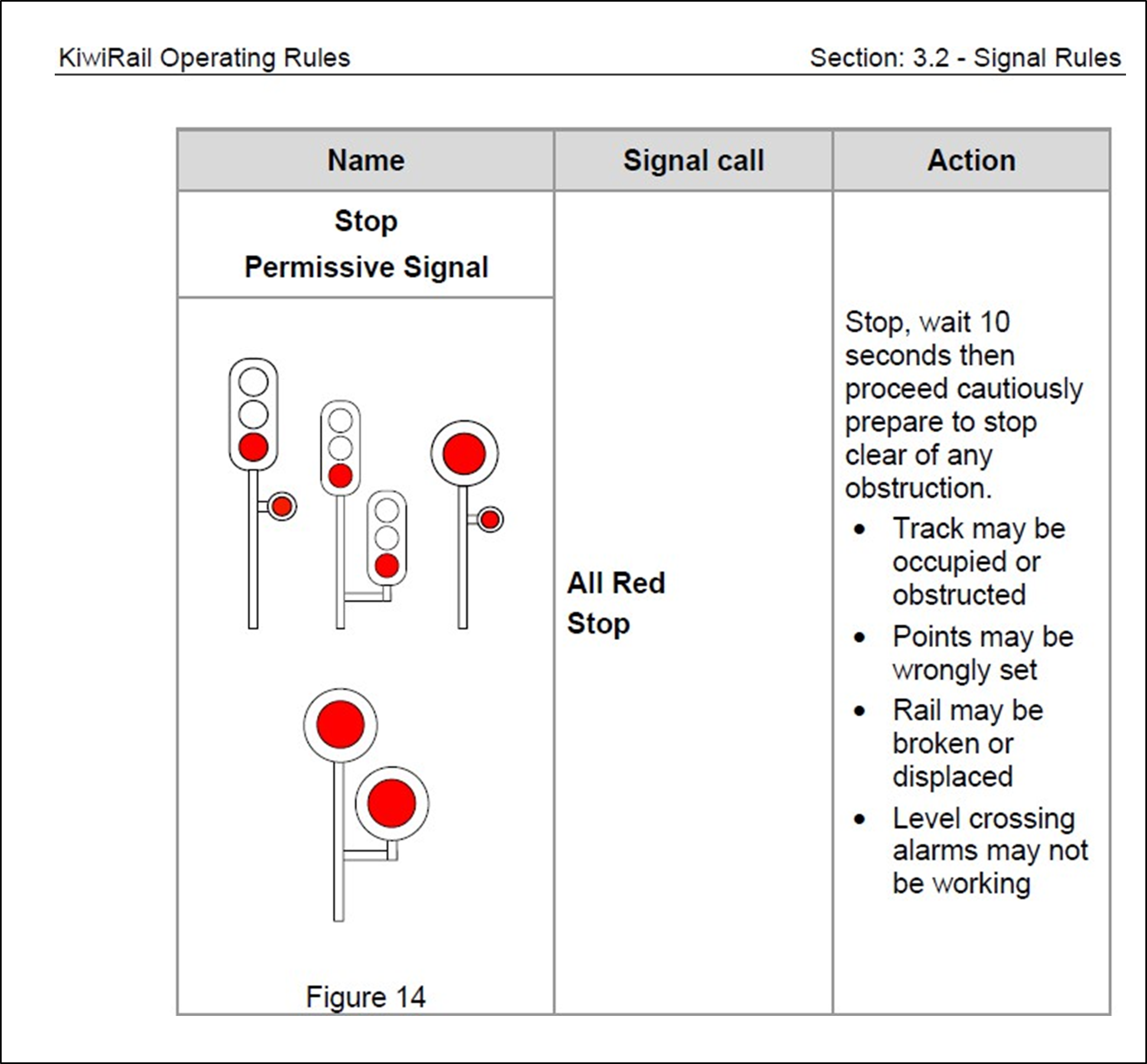Employers and managers of safety-critical workers, please note: workplace safety risk from after-effects of acute illnesses such as COVID-19. Can impair workers’ concentration, memory and thinking, including their ability to reliably self-assess as being fit to return to work. TAIC reports on occurrence where coal train missed and passed a stop signal, potentially into conflict with oncoming freight train.
Executive summary Tuhinga whakarāpopoto

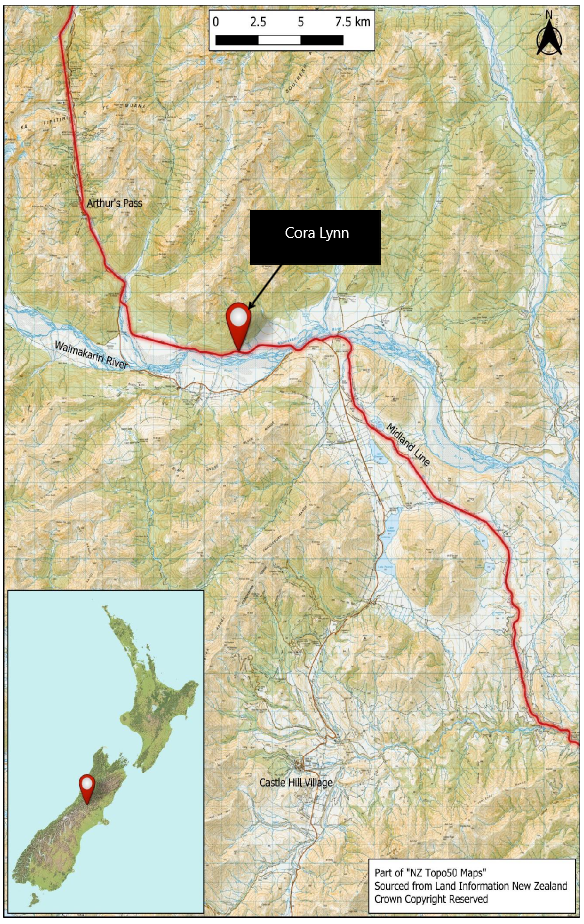
What happened
- At about 0800 (times used in this report are New Zealand Daylight Time (Universal Time Coordinated + 13 hours) and are expressed in 24-hour mode) on 27 February 2024 a loaded coal train (Train 850 with locomotive DXC5385, operated by KiwiRail) departed Arthur’s Pass station and was travelling towards Lyttelton.
- The locomotive engineer (LE) had taken over the train at Arthur’s Pass station. Before departure, train control (KiwiRail’s national train control centre in Wallaceville, Upper Hutt, which is responsible for track authorisations and the safe movement of rail traffic throughout New Zealand) had instructed the LE to cross another train at Cora Lynn, approximately 15 kilometres (km) east of Arthur’s Pass station.
- A yellow intermediate signal on the approach to Cora Lynn indicated that the arrival signal was at stop. However, the LE did not take the necessary steps to bring the train to a standstill before entering Cora Lynn. The train continued past the arrival signal at stop and entered the main line at 44 kilometres per hour (km/h).
- On this occasion the route was set for the train to enter the main line, not the loop where an opposing train was located, and a collision was avoided.
Why it happened
- While the LE could offer no explanation for not stopping at the arrival signal, they had very recently been unwell with COVID-19 while on annual leave. The LE stated that in hindsight they should not have returned to work while still suffering the after-effects of a COVID-19 infection.
What we can learn
- Acute illnesses, such as COVID-19, may impair cognitive functions such as memory and concentration for a period following recovery from the illness. Safety-critical workers should consider potential after-effects of an acute illness when self-assessing as being fit to return to work. Organisations employing safety-critical workers should also be aware that the after-effects of an acute illness may reduce a worker’s ability to reliably self-assess as being fit to return to work.
Who may benefit
- Organisations involved in safety-critical work, all safety-critical workers and their managers may benefit from the findings in this report.
Factual information Pārongo pono
Background
- The Midland line is a single-line railway and operates a traffic separation system known as Single-Line Automatic Signalling (SLAS). This system allows one train to follow another in the same direction, separated by intermediate signals.
- Where trains are required to cross (meet) an opposing train, the train controller informs each locomotive engineer (LE), by way of a Mis 51 Operating Instruction, at which crossing loop the trains will meet.
- Cora Lynn was a crossing loop between Arthur’s Pass and Cass (see Figure 3).
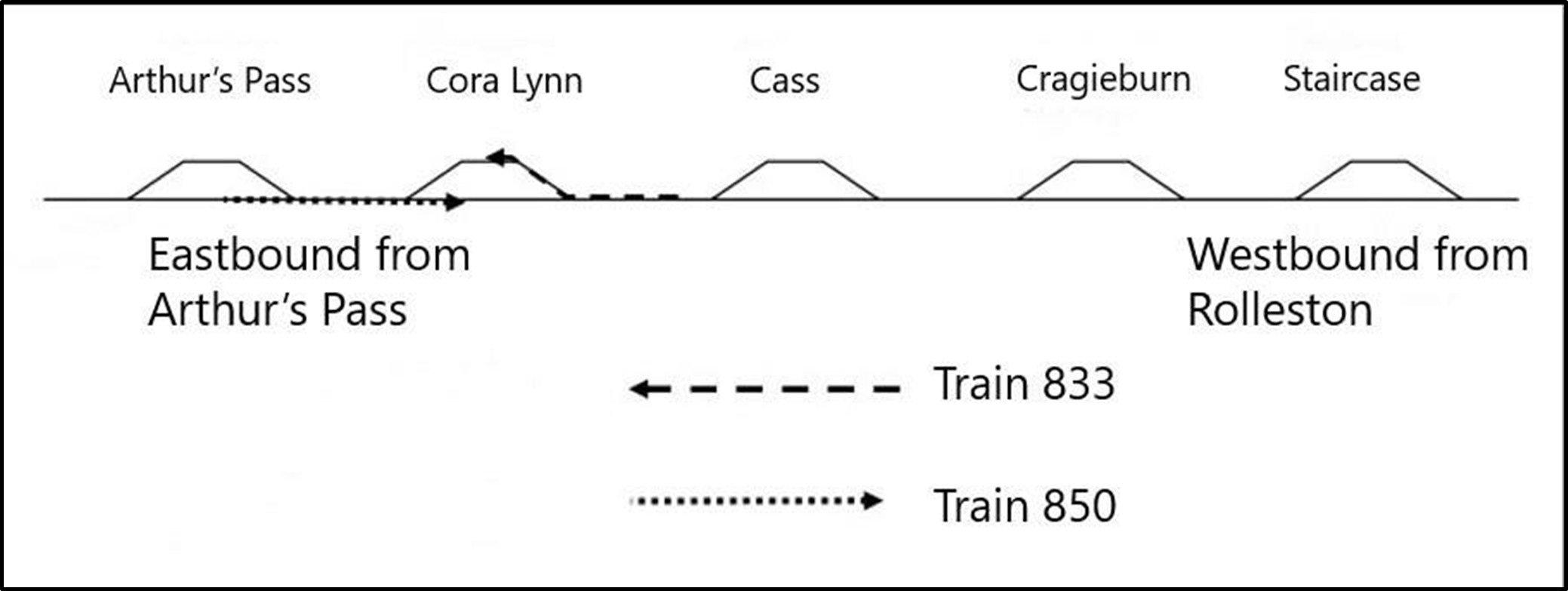
- The signals that govern entry to and exit from a crossing loop operate in isolation on simple closed-circuit logic. This means that if the points at both ends of the crossing loop are set for the main line, then the circuit is closed. With a closed circuit the arrival signal will display either a green or yellow aspect if the section ahead is clear (see Figure 4).
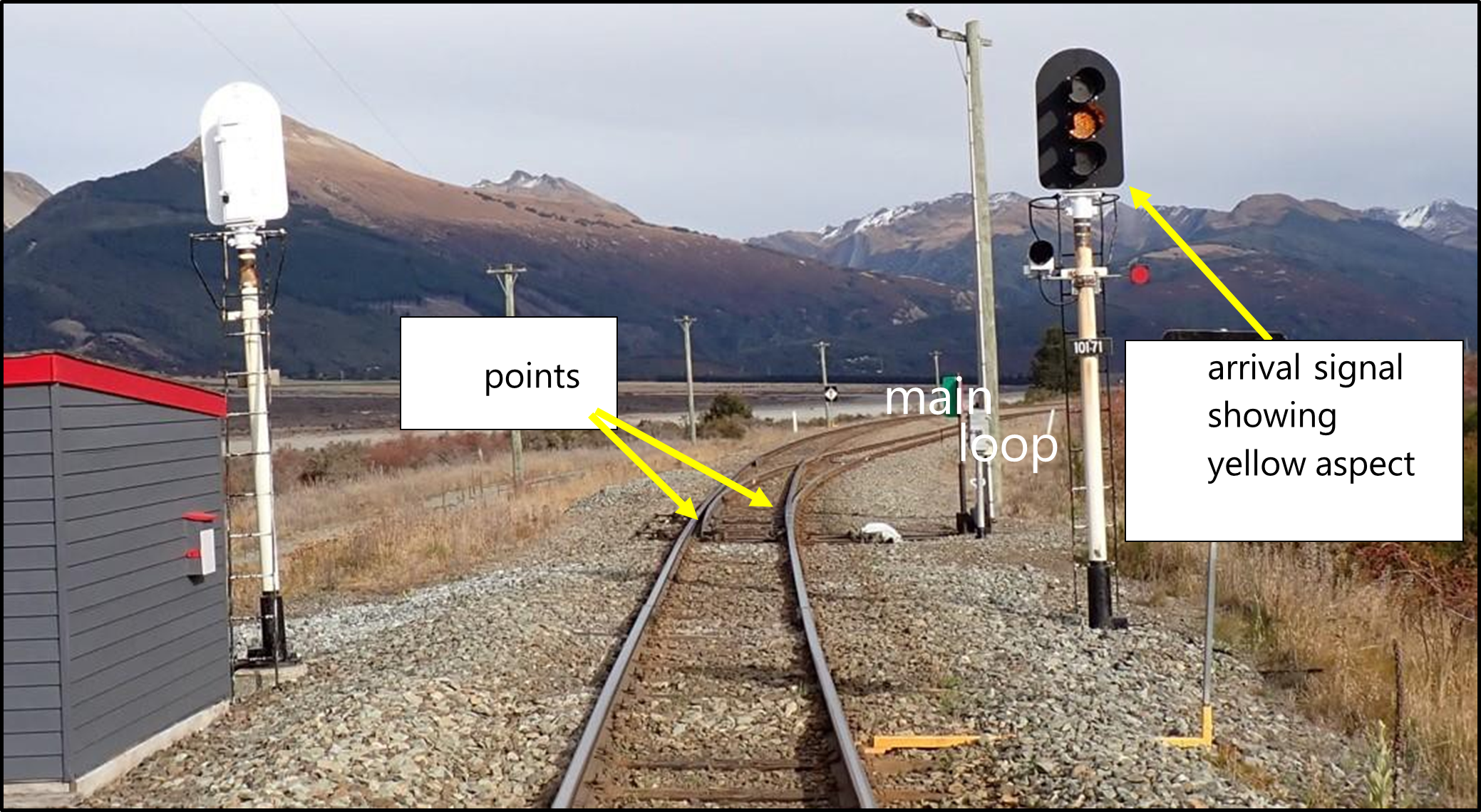
- If the points at either end are set for the loop, then the circuit is open. With an open circuit, the signals will display a red (stop) aspect at each end.
- On the incident journey, the west end arrival signal had a red aspect at Cora Lynn because the opposing train had entered the loop from the east end. This meant that the points at the east end were still set for the loop and the circuit was open.
- When facing a red signal, KiwiRail’s Rail Operating Rules and Procedures prescribe what action LEs should take dependent on whether they are crossing another train and whether they are taking their own train into the loop or the main line (see appendices 1 and 2).
- The correct action to take in this circumstance was for the LE to stop before the red arrival signal for a minimum of 10 seconds and visually confirm that the points at the west end were set for the main line.
- Not stopping to visually confirm the state of the points meant that the signal was passed at danger (referred to as a SPAD).
Narrative
- From 6 to 25 February 2024, the LE was on annual leave. During this period, they contracted COVID-19. Before returning to work on 26 February 2024 they thought that they had recovered sufficiently.
- On 26 February 2024, the LE started a shift at 0500 and drove without incident that day, completing a nine-and-a-half-hour shift at 1430. Before the end of the shift the LE was asked to start their shift earlier on the following day at 0300, to align with train scheduling requirements.
- At about 0400 on 27 February 2024, the LE departed Christchurch on Train 829, heading towards Arthur’s Pass for a scheduled crew change with Train 850.
- At 0620, Train 829 arrived outside Arthur’s Pass station limits, and awaited the arrival of Train 850, which was enroute through Otira tunnel.
- At 0715, Train 850 arrived at Arthur’s Pass station and, after detaching the banker locomotives, Train 829 entered Arthur’s Pass station and a crew change was conducted between the two LEs.
- Once onboard Train 850, the LE contacted train control and received a Mis 51 (A written instruction issued by train control to locomotive engineers on the Midland line. It contains information as to where trains will be crossed on a journey.) (see section 3 Analysis) before departing Arthur’s Pass station at 0745 bound for Lyttelton.
- The Mis 51 issued by train control gave details of the journey’s destination and the locations, between Arthur’s Pass and Rolleston, where other trains would be met. The first meeting was scheduled with Train 833 at Cora Lynn.
- Being in possession of the Mis 51 was not an authority to pass signals showing a red aspect. LEs still had to comply with signals in accordance with the prescribed SLAS rules of what action to take at crossing stations (see Appendix 1).
- At 0800:10, Train 850 passed intermediate signal 10530, approximately 3 km west of Cora Lynn (see Figure 5). This signal was indicating a yellow aspect, meaning that the next signal was at red (stop), informing the LE to take the necessary action to stop at the next signal.

- At 0802:13, as Train 850 approached Cora Lynn, the LE made a radio call to ascertain the location of Train 833. The Mis 51 recorded that the two trains were to cross at Cora Lynn.
- During this radio conversation, the LE of Train 833 confirmed that Train 833 was in the loop at Cora Lynn.
- Train 850 approached Cora Lynn at speeds between 50 and 56 km/h before slowing as it reached the Cora Lynn arrival signal.
- At 0803:25 Train 850 passed the Cora Lynn arrival signal 10244 (see Figure 6), which was indicating a red (stop) aspect, at a speed of 44 km/h.
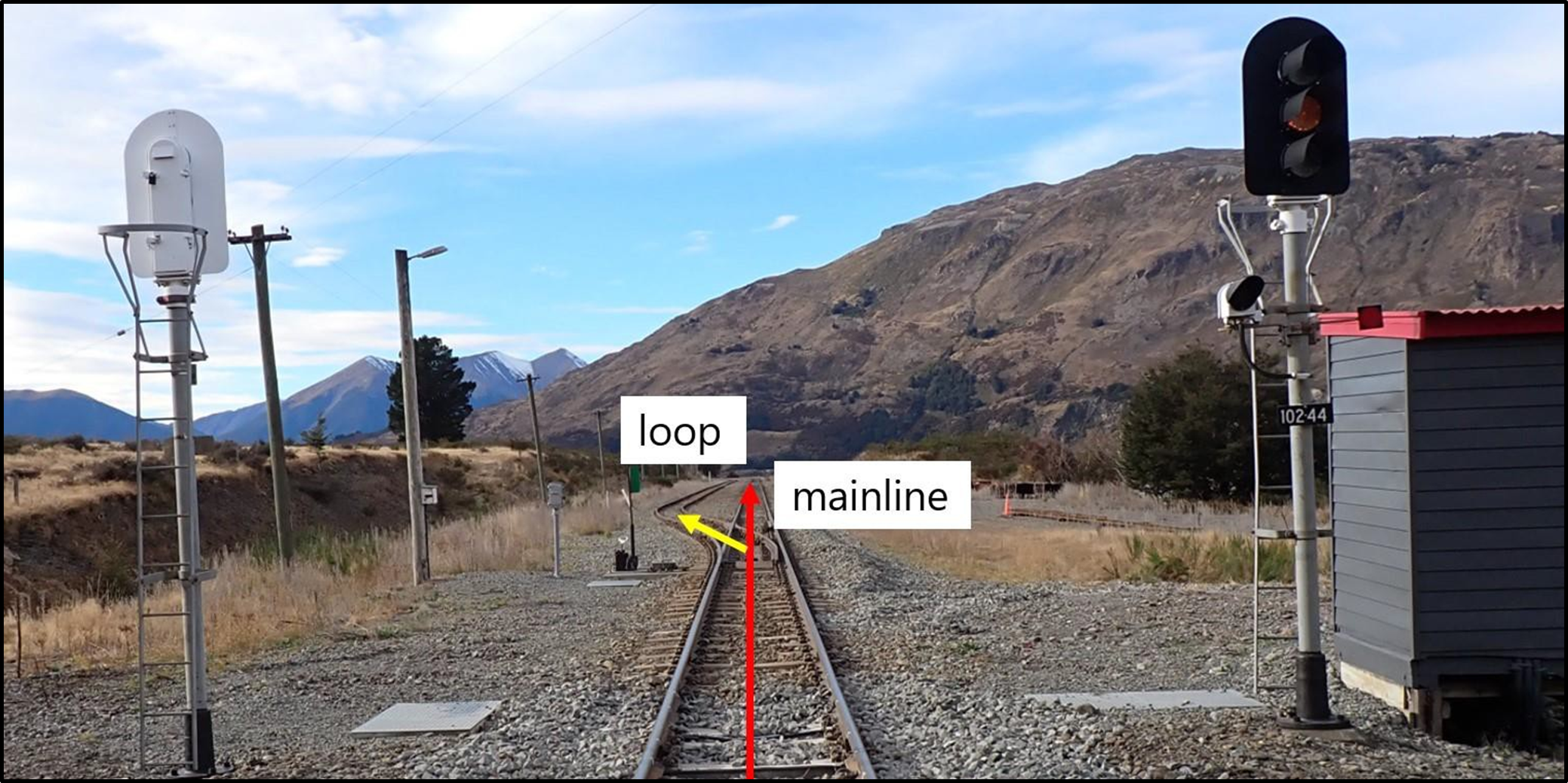
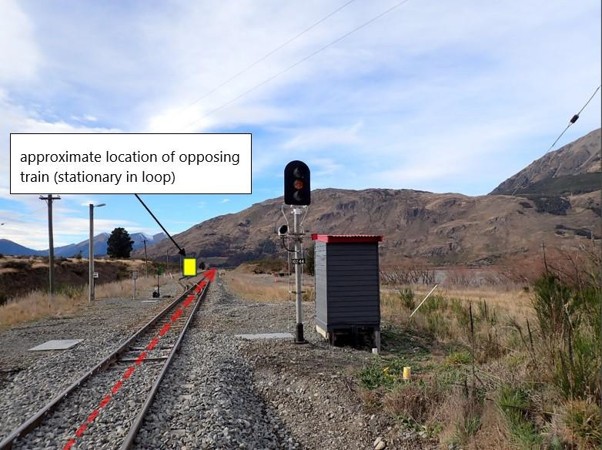
- Train 833 was positioned stationary in the loop (see Figure 7). The LE of Train 833 had disembarked and was walking towards the west end of Cora Lynn to set the points for departure from the loop when Train 850 went past on the main line.
- Train 850 should have stopped before signal 10244 for a minimum of 10 seconds to allow the LE to visually confirm that the points were set in the correct position for the main line before passing the signal.
- Instead, Train 850 continued past signal 10244 at stop, reducing speed before coming to a complete stop at the east end of Cora Lynn at 0805:38. The LE had to set the east end points for the main line as they were still set at reverse after Train 833 had entered the loop.
- Having set the points for the main line and obtained a proceed signal, the LE of Train 850 boarded the locomotive and departed Cora Lynn for Christchurch.
- KiwiRail’s Rail Operating Rules and Procedures state that safe-working incidents should immediately be reported to train control or a supervisor. On this occasion the incident was not reported immediately as both LEs stated in interviews that they were initially unaware that a SPAD had occurred.
- Once they became aware, the incident was reported to the KiwiRail Christchurch manager, who started internal investigation procedures.
Personnel information
- The LE of Train 850 had been employed by KiwiRail since 2012 and was certified in 2014. They had been a qualified LE overseas since 2008. They were a qualified instructor driver, training and mentoring trainee LEs.
Train/Vehicle information
- Train 850 was a loaded coal train powered by two DXC class diesel locomotives. It was 439 metres long and weighed 1904 tonnes.
Meteorological information
- The weather was clear and sunny, with good visibility. Sunstrike potentially affecting the intermediate and arrival signals is discussed in section 3 Analysis.
Recorded data
- The Commission obtained Tranzlog data from KiwiRail about locomotive DXC5385 on Train 850.
Organisational information
- KiwiRail Holdings Limited (trading as KiwiRail) was the operator of the railway line and employer of the LEs and train controller.
Previous occurrences
15 March 1923
- On 15 March 1923, an Arthur’s Pass to Christchurch passenger express derailed at the west end of Cora Lynn. The train was travelling at low speed in preparation to stop at the station. There were no injuries to train crew or any of the 50 passengers. It was reported at the time that the points at the west end were not correctly set, resulting in the engine and tender wagons derailing.
20 October 2005 (TAIC inquiry RO-2005-124)
- On 20 October 2005 at about 1900, eastbound express freight Train 834 was scheduled to cross with westbound express freight Train 841 at Cora Lynn. Train 841 was berthed on the loop when Train 834 also entered the loop and collided head on with Train 841.
- Both locomotives were extensively damaged, but there was no damage to the wagons on either train or to the track infrastructure. The LEs suffered minor injuries.
- On 9 January 2006 the Commission recommended that the Chief Executive of ONTRACK (New Zealand’s rail network provider before the formation of KiwiRail in 2008) review existing signalling and interlocking arrangements and operating procedures at SLAS crossing stations on the Midland line, with a view to introducing enhanced operating practices or engineering modifications to reduce the risk of a collision resulting from the overrunning of a signal at stop.
- On 7 February 2006 ONTRACK responded that it accepted the recommendation.
- Safety action taken by Toll Rail (KiwiRail’s predecessor) included:
- issuing a safety briefing to operational staff summarising incidents in which procedural non-compliance was a significant contributory factor
- increasing compliance monitoring, including unannounced casual observation and examination of randomly selected Tranzlog data
- reviewing the existing signalling system, resulting in the implementation of ‘high-stand’ points position indicators to assist LE’s to confirm if points were set correctly.
Analysis Tātaritanga
Introduction
- The following section analyses the circumstances surrounding the event to identify those factors that increased the likelihood of the event occurring or increased the severity of its outcome.
Events leading up to the incident
- The LE started their shift at 0300 that morning, two hours before their original rostered start time, because of train scheduling requirements.
- As it was only their second shift back after returning from three weeks’ annual leave the LE was not concerned that they would be fatigued. The LE had agreed to the proposed roll-back of two hours as this still provided a 12-and-a-half-hour break since their previous shift.
- The LE was assigned to take Train 829 from Christchurch to Arthur’s Pass. This service departed about 15 minutes behind schedule, arriving outside Arthur’s Pass station at about 0637. Train 850, on which the LE was rostered to drive back to Christchurch, was running about 50 minutes behind schedule, arriving at Arthur’s Pass station at 0717.
- Because of the late running of Train 850, the LE of Train 829 remained outside Arthur’s Pass station until shunting activities were completed and there was room for both trains in the station.
- By the time Train 829 entered Arthur’s Pass station, Train 850 was still running 50 minutes behind its scheduled departure and Train 829 was now 70 minutes behind.
- The LE was aware that Train 850 would need to depart for Christchurch as soon as possible for the LE to remain within their rostered hours, and to avoid causing a delay to the TranzAlpine passenger train.
- With knowledge of these two factors, the LE departed Arthur’s Pass station on Train 850 within seven minutes of arriving on Train 829, after receiving the necessary Mis 51 from train control.
Single-Line Automatic Signalling (SLAS)
- The Midland line operated the SLAS signalling system, in which LEs drove in accordance with fixed signals. In addition to fixed signals, the issuance of a Mis 51 was also necessary, in part to provide LEs the opportunity to plan what actions needed to be taken at particular crossing stations.
- The Mis 51 provided to the LE contained notice of two crossings: the first at Cora Lynn with Train 833, and the second at Springfield with the TranzAlpine passenger train, Train 803 (see Figure 8).

- This combination of fixed signals and the Mis 51 meant that the SLAS system provided additional information to the LE compared to the centralised traffic control (CTC) signalling areas, which are more commonplace within the KiwiRail network.
- The main difference between the SLAS and CTC systems was that CTC was operated remotely by a train controller ‘setting the path’ for trains. LEs were not required to stop their train to manually move points unless a fault occurred.
- Conversely, some stations within the SLAS area (namely Cora Lynn, Cass, Craigieburn and Staircase) were not automated. Those stations required intervention from the LE to ensure that points were set correctly, either by visual inspection or, where necessary, disembarking from the locomotive cab to manually operate points levers for the correct route (see Figures 9 and 10).
- This relied on LEs following procedures and taking the correct actions to stop, as no engineering controls were in place to prevent trains from passing signals at stop and continuing into an incorrectly set route potentially occupied by another train.
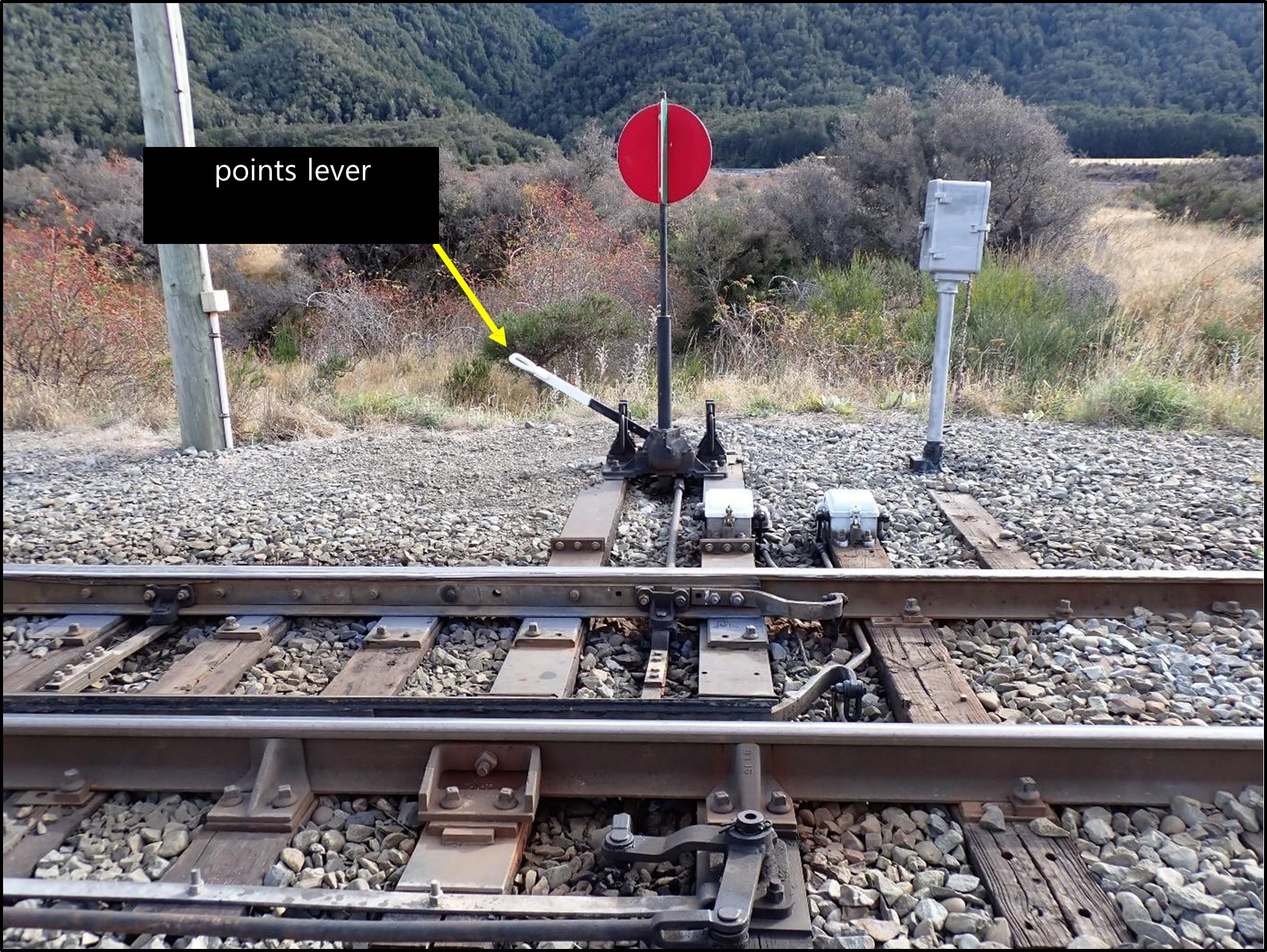
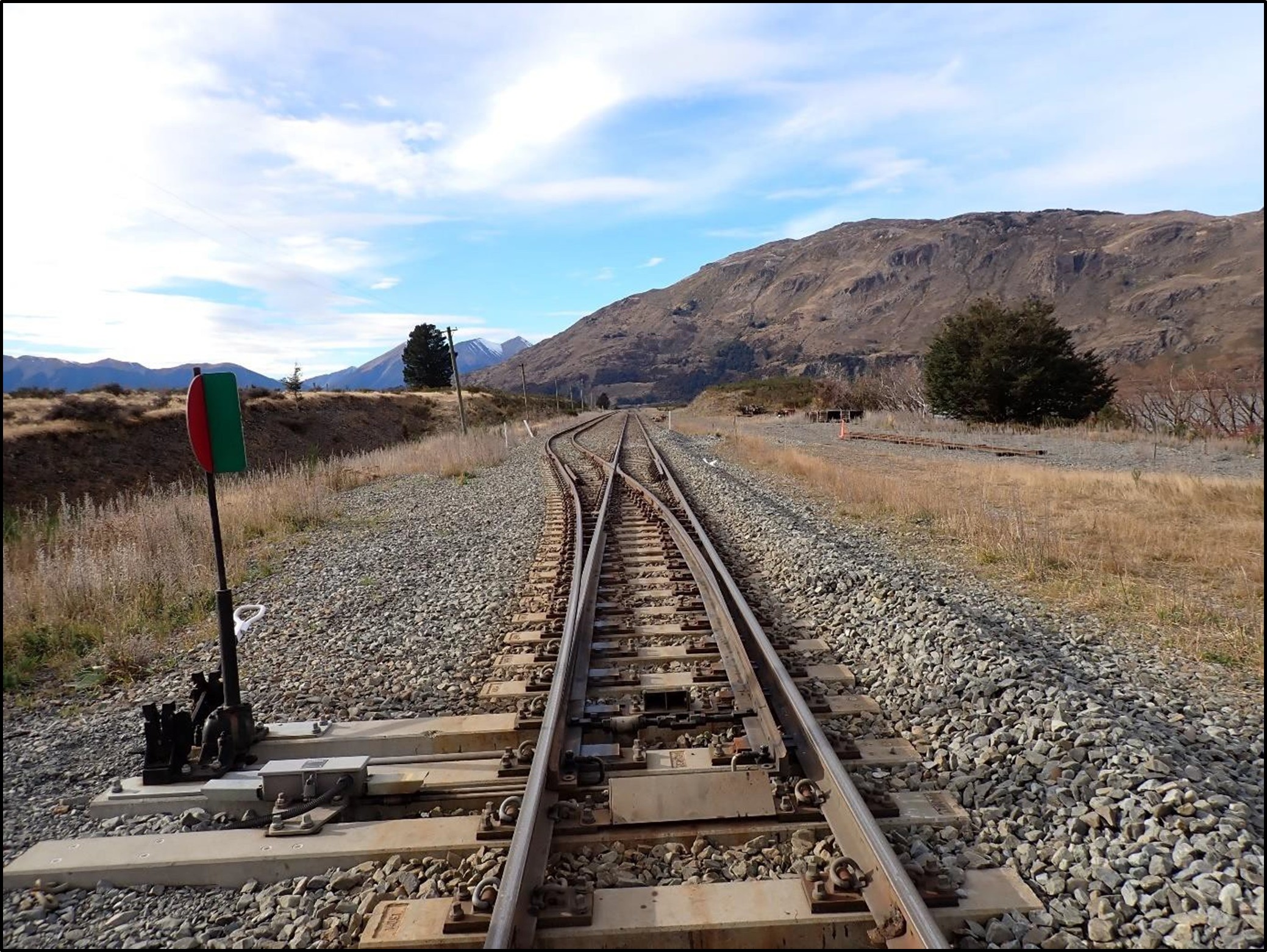
- At the time of the incident, the procedure to be followed by LEs at SLAS crossing stations was set out in KiwiRail’s Rail Operating Rules and Procedures (RORP) Section 6a – Midland Line Appendix (see Appendix 1). For Cora Lynn, the RORP required the LE to stop their train before signal 10244 for at least 10 seconds and visually inspect the west end points to ensure they were correctly set before entering the main line.
- KiwiRail requires LEs to be proficient in their knowledge of RORP Section 6a before they are certified to drive on the Midland line. The LE of Train 850 was considered by KiwiRail to be very experienced and was involved with the training and mentoring of trainee and newly qualified LEs on the Midland line.
- In order to determine the circumstances and causes of the incident, the Commission considered the following factors, each discussed further below:
- deliberate act
- sunstrike
- signalling system error
- performance-impairing substances
- performance impairment because of illness.
Deliberate act
- During its investigation into a collision between two trains at Cora Lynn in 2005, the Commission found that there had been a limited practice of LEs deliberately breaching safety-critical procedures by passing arrival signals at stop to lessen the likelihood of stalling on grades, and to pick up time on a continually late-running operation (see TAIC inquiry report RO-2005-124 (page 38, paras 2.5–2.6)).
- In 2006, Toll Rail (KiwiRail’s predecessor) took safety action following the accident, which included increased monitoring to reduce non-compliance with the SLAS rules.
- In 2007, the Commission recommended to the Director of Land Transport New Zealand that they “review Toll Rail’s compliance monitoring of locomotive engineers to confirm that the increased monitoring as defined in the safety action of 21 February 2006 has been implemented and is effective.”
- In relation to the current incident, during interviews with both LEs they stated that they were not aware of a current accepted practice amongst Midland line staff to contravene SLAS rules. The Commission found no evidence that the practice had continued once safety action was taken after the 2005 incident.
- Based on the KiwiRail LE compliance monitoring regime, interviews with the LEs and the change in safety-culture expectations of LEs since 2005, it is unlikely that the LE deliberately passed the arrival signal at stop to avoid stopping their train.
Sunstrike affecting signal visibility
- During interview the LE described the sun rising above the horizon as the train approached Cora Lynn, making signal 10244 difficult to see at that time of the morning. However, the previous signal (10530) had displayed a yellow aspect, meaning that the LE would be expecting that the next signal (10244) to be at red (stop).
- The LE stated that they could not recall what aspect was displayed on signal 10530. After passing the signal they made radio calls to the LE of Train 833 to establish their location and before approaching signal 10244 were aware that Train 833 was in the loop at Cora Lynn.
- The LE was an experienced train driver and was in possession of a Mis 51 instruction that advised of a crossing at Cora Lynn. Whether they had seen the yellow aspect on signal 10530 or not, they were aware by radio communications that an opposing train had recently entered the loop. This would have informed the LE that signal 10244 would be at stop, and that they needed to take action to stop Train 850 before passing the signal in order to check the setting of the points.
- The Commission considers it very unlikely that sunstrike contributed to the incident.
Signalling system error
- Post-incident, KiwiRail examined and conducted testing of the points and signalling arrangement at the west end of Cora Lynn. KiwiRail identified no faults.
- It is virtually certain that there was no fault with the signalling system contributing to the incident.
Performance-impairing substances
- While on annual leave before the incident the LE had been unwell with COVID-19. During interview, the LE gave details of the medication they had taken. This did not include any potentially performance-impairing substances.
- As there was a delay between the incident being reported and the LE returning to work, post-incident drug and alcohol screening could not be completed.
Performance impairment because of illness
- Medical advice received by the Commission was that potential effects of COVID-19 on cognitive impairment (‘brain fog’) are well documented and can be long-lasting, continuing after the infection has cleared.
- During interview, the LE explained that although they did not feel fully recovered from COVID-19, they felt an obligation to return to work to support their team. They further stated that “in hindsight” they should not have done so as they did not feel completely well and so were unlikely to be fit for work.
- Nevertheless, the LE was on their second shift back from annual leave when the incident occurred, and they had conducted their duties effectively during their first shift.
- The LE could not remember the indication on signal 10530 and were unaware that signal 10244 had been passed at stop. Symptoms of cognitive impairment because of a recent COVID-19 illness can include temporary lapses in concentration and a reduced capacity for situational awareness.
- Based on the above analysis, the Commission found it is about as likely as not that the incident occurred because the LE was cognitively impaired following a recent COVID-19 illness.
- The Commission has identified a key lesson in section 7 for safety-critical workers and organisations.
Findings Ngā kitenga
- It is unlikely that the LE deliberately passed the arrival signal at stop to avoid stopping their train.
- It is very unlikely that sunstrike contributed to the incident.
- It is virtually certain that there was no fault with the signalling system contributing to the incident.
- It is about as likely as not that the incident occurred because the LE was cognitively impaired following a recent COVID-19 illness.
Safety issues and remedial action Ngā take haumaru me ngā mahi whakatika
General
- Safety issues are an output from the Commission’s analysis. They may not always relate to factors directly contributing to the accident or incident. They typically describe a system problem that has the potential to adversely affect future transport safety.
- Safety issues may be addressed by safety actions taken by a participant, otherwise the Commission may issue a recommendation to address the issue.
- No new safety issues were identified.
Recommendations Ngā tūtohutanga General
General
- The Commission issues recommendations to address safety issues found in its investigations. Recommendations may be addressed to organisations or people, and can relate to safety issues found within an organisation or within the wider transport system that have the potential to contribute to future transport accidents and incidents.
- In the interests of transport safety, it is important that recommendations are implemented without delay to help prevent similar accidents or incidents occurring in the future.
New recommendations
- No new recommendations were issued.
Key lesson Ngā akoranga matua
- Acute illnesses such as COVID-19 may impair cognitive functions like memory and concentration for a period following recovery from the illness. Safety-critical workers should consider potential after-effects of an acute illness when self-assessing as being fit to return to work. Organisations employing safety-critical workers should be aware that the after effects of an acute illness may reduce a worker’s ability to reliably self-assess as being fit to return to work.
Data summary Whakarāpopoto raraunga
Train type and number
Train 850, lead locomotive DXC5385
Classification
Loaded coal train
Operator
KiwiRail Holdings Limited (trading as KiwiRail)
Details
Date and time
Location
10244 signal Cora Lynn
Injuries
Nil
Persons involved
1 x locomotive engineer
Damage
Nil
Conduct of the Inquiry Te whakahaere i te pakirehua
- On 1 March 2024, the New Zealand Transport Agency Waka Kotahi notified the Commission of the occurrence. The Commission subsequently opened an inquiry under section 13(1) of the Transport Accident Investigation Commission Act 1990 and appointed an investigator in charge.
- The Commission obtained records and information from sources that included:
- interviews with train crews
- train control graphs and voice recordings
- Tranzlog downloads
- Mis 51 operating instructions
- photographs of the incident site
- records of examination by signalling technicians.
- On 23 October 2024 the Commission approved a draft report for circulation to four interested parties for their comment.
- Three interested parties responded. One interested party did not respond despite efforts to contact them. Any changes as a result of the submissions have been included in the final report.
- On 11 December 2024, the Commission approved the final report for publication.
Glossary Kuputaka
- Aspect
- The aspect of a signal is the visual appearance of a lit signal.
- Banker locomotives
- Banker locomotives are additional locomotives used when required to assist trains up steep gradients.
- Cross
- On a single-line railway, trains travelling in opposite directions can pass each other at certain locations by one of the trains pulling into a sidetrack known as a crossing loop. This is known as either a ‘cross’ or ‘meet’ of trains.
- Intermediate signal
- A signal within an automatic signalling area used to keep trains travelling in the same direction safely separated by indicating proceed if the section ahead is clear or indicating stop if the section is occupied. These signals divide the line between stations into shorter sections and control the entry of trains into such sections.
- Mis 51
- KiwiRail form issued as an operating instruction
- Point lever
- A manually operated lever that moves the points (movable part of the track that guides rail traffic from one track to another). Points can be set at normal or reverse, dependent on what direction is required for rail traffic.
- SPAD
- Rail terminology for the act of a signal having been passed at danger. This occurs when a train should have stopped for a red signal but has continued past it.
Appendix 1. Operating Rules – Midland line


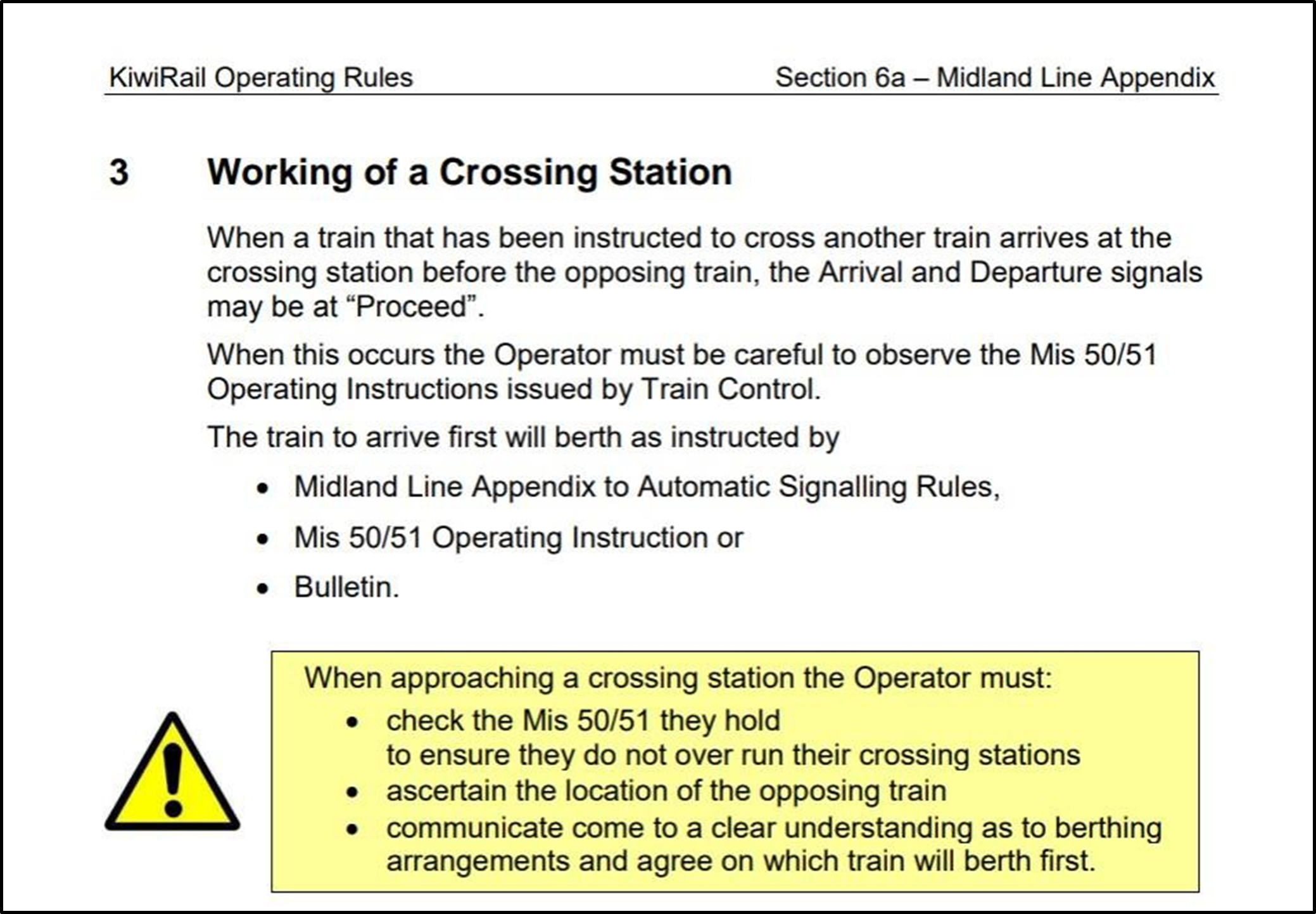


Appendix 2. Operating Rules – Signal Rules
